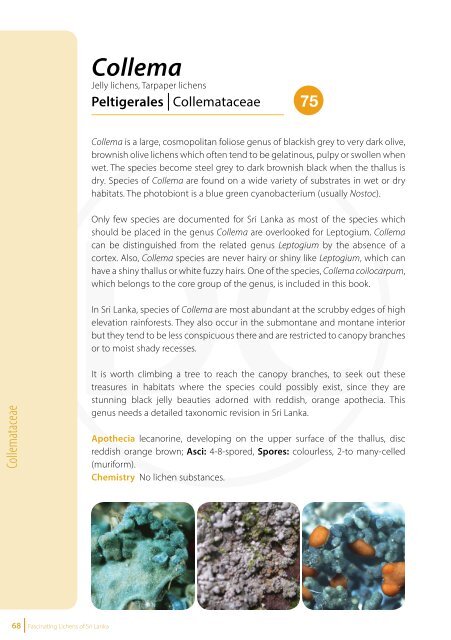Create successful ePaper yourself
Turn your PDF publications into a flip-book with our unique Google optimized e-Paper software.
Collema<br />
Jelly lichens, Tarpaper lichens<br />
Peltigerales Collemataceae<br />
75<br />
Collema is a large, cosmopolitan foliose genus <strong>of</strong> blackish grey to very dark olive,<br />
brownish olive lichens which <strong>of</strong>ten tend to be gelatinous, pulpy or swollen when<br />
wet. The species become steel grey to dark brownish black when the thallus is<br />
dry. Species <strong>of</strong> Collema are found on a wide variety <strong>of</strong> substrates in wet or dry<br />
habitats. The photobiont is a blue green cyanobacterium (usually Nostoc).<br />
Only few species are documented for <strong>Sri</strong> <strong>Lanka</strong> as most <strong>of</strong> the species which<br />
should be placed in the genus Collema are overlooked for Leptogium. Collema<br />
can be distinguished from the related genus Leptogium by the absence <strong>of</strong> a<br />
cortex. Also, Collema species are never hairy or shiny like Leptogium, which can<br />
have a shiny thallus or white fuzzy hairs. One <strong>of</strong> the species, Collema coilocarpum,<br />
which belongs to the core group <strong>of</strong> the genus, is included in this book.<br />
Collemataceae<br />
In <strong>Sri</strong> <strong>Lanka</strong>, species <strong>of</strong> Collema are most abundant at the scrubby edges <strong>of</strong> high<br />
elevation rainforests. They also occur in the submontane and montane interior<br />
but they tend to be less conspicuous there and are restricted to canopy branches<br />
or to moist shady recesses.<br />
It is worth climbing a tree to reach the canopy branches, to seek out these<br />
treasures in habitats where the species could possibly exist, since they are<br />
stunning black jelly beauties adorned with reddish, orange apothecia. This<br />
genus needs a detailed taxonomic revision in <strong>Sri</strong> <strong>Lanka</strong>.<br />
Apothecia lecanorine, developing on the upper surface <strong>of</strong> the thallus, disc<br />
reddish orange brown; Asci: 4-8-spored, Spores: colourless, 2-to many-celled<br />
(muriform).<br />
Chemistry No lichen substances.<br />
Collema coilocarpum<br />
Description Foliose. The thallus is mainly corticolous, and the upper side is olive<br />
grey, becoming purplish grey blue when dry (latter photos). Isidia are not found,<br />
but <strong>of</strong>ten develop erect, thickened lobules or cylindrical outgrowths can be seen<br />
that resemble isidia and can dominate the thallus (as shown in photos). Thallus is<br />
very pulpy and swollen when wet. Apothecia are dense. Discs are orange brown.<br />
The other species which is known to me in <strong>Sri</strong> <strong>Lanka</strong> is Collema pulcellum var.<br />
subnigrescens. But the species needs clarification with fresh sampling. It has a<br />
dark blackish olive green upper surface that is deeply ridged. Only seen in one<br />
place at Nuwara Eliya.<br />
C<br />
Fo<br />
Collemataceae<br />
Status Common, cosmopolitan species. The species is known to <strong>Sri</strong> <strong>Lanka</strong> from<br />
early lichen collections and has been documented many times.<br />
Habitat Mainly seen on the mature canopy branches <strong>of</strong> trees in rainforest edges,<br />
submontane and montane areas.<br />
Locations Central highlands, high elevation wet zone forests, Meemure and<br />
Kalupahana areas <strong>of</strong> the Knuckles mountain region.<br />
68 <strong>Fascinating</strong> <strong>Lichens</strong> <strong>of</strong> <strong>Sri</strong> <strong>Lanka</strong><br />
<strong>Fascinating</strong> <strong>Lichens</strong> <strong>of</strong> <strong>Sri</strong> <strong>Lanka</strong> 69















